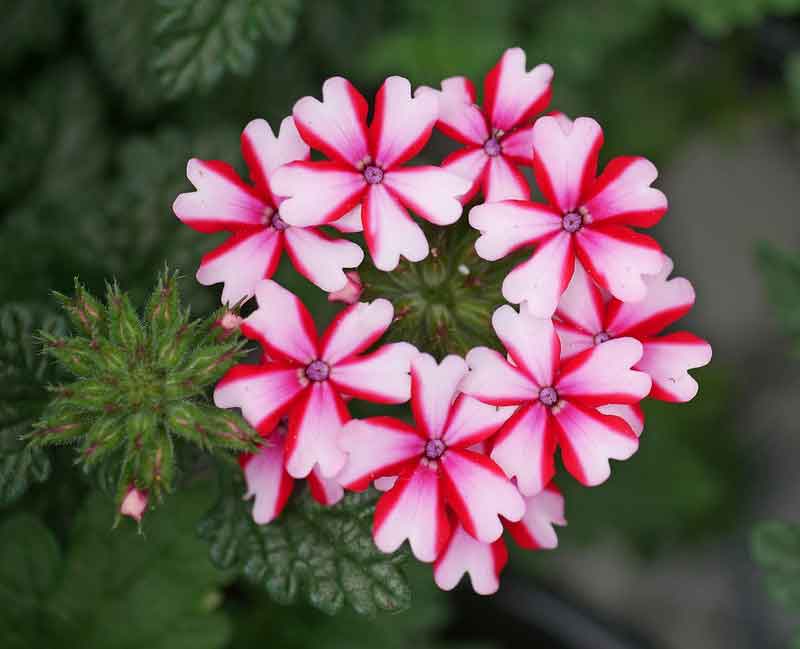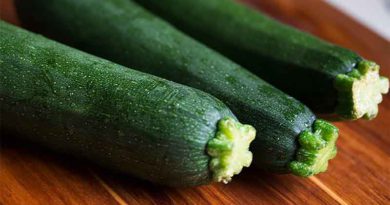Verbena Plants: The Ultimate Growing Guide
Welcome to our comprehensive guide on growing and maintaining verbena plants. These versatile and vibrant perennials are a great addition to any garden, providing pops of color and attracting pollinators. Follow our step-by-step instructions to cultivate a thriving verbena garden that will leave your neighbors green with envy.
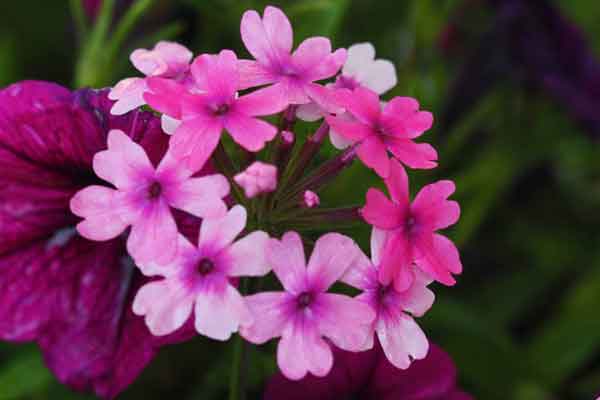
Understanding the Missouri Verbena Varieties
Verbena plants are incredibly diverse, with over 250 species and numerous hybrids to choose from. To help you select the perfect variety for your garden, we’ve provided more detailed information on some popular options:
-
Verbena bonariensis (Purpletop Vervain): This perennial species is native to South America and features slender, square stems that can reach heights of 3-6 feet. The tiny, tubular purple flowers form dense clusters at the tips of the stems, creating an airy, cloud-like effect. Verbena bonariensis is a magnet for butterflies and bees and is often used in cottage gardens or as a backdrop for lower-growing plants.
-
Verbena canadensis (Homestead Purple Verbena): A versatile, low-growing perennial, Verbena canadensis is known for its trailing habit and vibrant purple flowers. It is a great choice for rock gardens, hanging baskets, or as ground cover. Homestead Purple is a popular cultivar, showcasing deep purple blooms from spring to fall.
-
Verbena rigida (Slender Vervain): This South American native is a compact, bushy perennial with a height of 1-2 feet. Its lance-shaped, toothed leaves give way to dense clusters of tubular purple, blue, or white flowers. Verbena rigida is drought-tolerant and well-suited for borders, containers, or mass plantings.
-
Verbena x hybrida (Annual Verbena): A popular choice for annual bedding displays, this hybrid variety boasts a range of flower colors, including red, pink, white, and purple. It grows up to 12 inches tall and is perfect for containers, window boxes, or borders. Some popular cultivars include Tuscany, Imagination, and Obsession.
-
Verbena hastata (Blue Vervain): Native to North America, this perennial species reaches 2-6 feet in height and produces slender, branched spikes of small, tubular blue flowers. Its toothed leaves are lance-shaped and arranged opposite each other on square stems. Blue Vervain is an excellent choice for rain gardens or naturalized areas, as it thrives in moist to wet soils.
Consider factors such as growth habit, flower color, and garden use when selecting the ideal verbena variety for your landscape. By doing so, you’ll create a visually stunning and cohesive garden design.
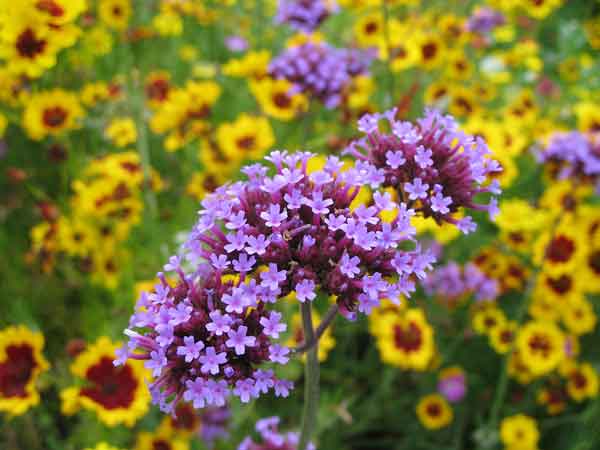
Ideal Growing Conditions for Missouri Verbena
To ensure your verbena plants flourish, it is crucial to provide them with the optimal growing conditions. Here, we expand on the essential factors to consider when cultivating these vibrant perennials:
Sunlight
Verbena plants thrive in full sun exposure, which means they require at least 6-8 hours of direct sunlight per day. Adequate sunlight is vital for promoting healthy growth, abundant flowering, and vibrant colors. If your garden receives less than the ideal amount of sunlight, choose a verbena variety that is more shade-tolerant, such as Verbena hastata.
Soil
Well-draining soil is essential for verbena plants, as they are susceptible to root rot in overly wet conditions. They can tolerate a range of soil types, including sandy, loamy, and clay soils. However, they prefer moderately fertile, loamy soil with a pH between 6.0 and 7.0. If your soil is heavy clay or consistently damp, consider planting verbena in raised beds or containers to improve drainage.
Water
Verbena plants are relatively drought-tolerant once established but require regular watering during the initial growth phase. Water your verbena deeply and consistently, allowing the soil to dry out slightly between waterings. Overwatering or inconsistent moisture can lead to root rot and other diseases, so be sure to monitor the moisture level in the soil to avoid waterlogged conditions.
Temperature and Climate
Most verbena varieties are hardy in USDA zones 4-9, but some, such as Verbena bonariensis, may need additional winter protection in colder climates. In warmer regions, verbena can be grown as a perennial, while in cooler climates, some varieties may be treated as annuals. If you live in a region with extreme temperatures, choose a verbena variety that is best suited for your climate.
Fertilization
While verbena plants aren’t heavy feeders, they do benefit from regular fertilization. Apply a balanced, slow-release granular fertilizer in the spring to promote vigorous growth and flowering. Alternatively, use a liquid fertilizer every 4-6 weeks during the growing season. Avoid over-fertilizing, as excessive nutrients can lead to lush foliage growth at the expense of flowering.
By providing your verbena plants with the ideal growing conditions, you will create a thriving garden full of healthy plants and vibrant blooms.
Planting and Propagation Techniques for Verbena
To achieve a thriving verbena garden, understanding proper planting and propagation techniques is essential. Follow these steps to ensure the successful growth and establishment of your verbena plants:
Planting
- Timing: Plant your verbena in the spring or early fall, when soil temperatures are between 60-70°F (15-21°C). This allows the plants to establish a strong root system before extreme weather conditions arise.
- Site Preparation: Choose a location with full sun exposure and well-draining soil. If necessary, amend the soil with organic matter, such as compost or well-rotted manure, to improve fertility and drainage.
- Spacing: Allow adequate space between plants to encourage airflow and prevent disease. Space smaller varieties 12-18 inches (30-45 cm) apart and larger varieties 24-36 inches (60-90 cm) apart.
- Planting Depth: Dig a hole as deep as the root ball and twice as wide. Gently remove the plant from its container and loosen the roots. Place the plant in the hole, ensuring the top of the root ball is level with the soil surface. Fill the hole with soil and water thoroughly to settle the soil around the roots.
Propagation
There are several methods to propagate verbena plants, including seeds, cuttings, and division:
-
Seeds: Start seeds indoors 8-10 weeks before your last frost date or sow them directly outdoors after the threat of frost has passed. Lightly press the seeds into the soil surface, as they require light to germinate. Maintain consistent moisture and a temperature of 70-75°F (21-24°C) until germination occurs, typically within 14-21 days.
-
Cuttings: To propagate verbena from cuttings, take a 4-6 inch (10-15 cm) stem cutting from a healthy, non-flowering shoot in late spring or early summer. Remove the lower leaves and dip the cut end in rooting hormone. Insert the cutting into moist, well-draining potting mix and cover with a plastic bag or dome to maintain humidity. Place the cutting in a warm, bright location out of direct sunlight. Roots should develop within 4-6 weeks, at which point the cutting can be transplanted into the garden.
-
Division: Divide established verbena plants in the spring or fall to maintain vigor and increase your stock. Dig up the plant, taking care not to damage the roots. Gently separate the plant into smaller sections, each with a healthy root system and foliage. Replant the divisions immediately, ensuring they are well-watered and protected from extreme weather conditions during the initial establishment period.
By implementing proper planting and propagation techniques, you’ll create a lush, thriving verbena garden that will be the envy of your neighborhood.
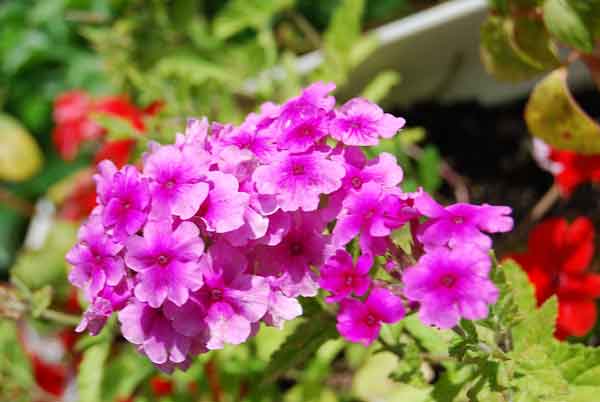
Caring for Your Verbena in Missouri
Proper care and maintenance are crucial for a flourishing verbena garden. Follow these guidelines to ensure your plants remain healthy, vibrant, and full of blooms:
Watering
Verbena plants are fairly drought-tolerant once established, but they do require consistent watering during their initial growth phase. Water your plants deeply and consistently, allowing the soil to dry out slightly between waterings. Avoid overwatering, as this can lead to root rot and other diseases. During periods of drought or extreme heat, you may need to water more frequently to prevent wilting.
Mulching
Applying a layer of organic mulch, such as bark chips or shredded leaves, around the base of your verbena plants helps conserve moisture, suppress weeds, and regulate soil temperature. Ensure the mulch is 2-3 inches (5-7.5 cm) deep but not piled up against the plant stems, as this can lead to rot and pest infestations.
Fertilizing
While verbena plants aren’t heavy feeders, they do benefit from regular fertilization. Apply a balanced, slow-release granular fertilizer in the spring or use a liquid fertilizer every 4-6 weeks during the growing season. Avoid over-fertilizing, as excessive nutrients can lead to lush foliage growth at the expense of flowering.
Deadheading
Regularly remove spent flowers to encourage continuous blooming and maintain a tidy appearance. Deadheading not only promotes further flowering but also helps prevent self-seeding, which can lead to overcrowding in the garden.
Monitoring for Pests and Diseases
Inspect your plants regularly for signs of pests or diseases. Aphids, spider mites, and powdery mildew are common issues that can affect verbena. Treat any infestations or diseases promptly to minimize damage and prevent spread to other plants.
Providing Support
Taller verbena varieties, such as Verbena bonariensis, may require staking or support to prevent them from toppling over in heavy rain or wind. Use garden stakes, bamboo canes, or plant supports to provide additional stability.
By following these care guidelines, your verbena plants will reward you with a stunning display of colorful blooms throughout the growing season.
Pest and Disease Control for Verbena
Protecting your verbena plants from pests and diseases is essential for maintaining a thriving garden. Here, we outline common issues and offer effective solutions to keep your plants healthy and vibrant:
Pests
-
Aphids: These small, sap-sucking insects can cause distorted foliage and transmit viruses. To control aphids, dislodge them with a strong spray of water, release beneficial insects such as ladybugs, or apply insecticidal soap or neem oil.
-
Spider Mites: Spider mites feed on plant sap, causing stippled leaves and webbing. Increase humidity around the plants, introduce predatory mites, or use insecticidal soap or neem oil to combat infestations.
-
Slugs and Snails: These pests feed on verbena leaves, creating holes and ragged edges. Handpick slugs and snails from your plants, use beer traps, or apply diatomaceous earth or organic slug bait to control their populations.
Diseases
-
Powdery Mildew: This fungal disease appears as a white, powdery substance on leaves and stems, causing distortion and stunted growth. Improve air circulation, avoid overhead watering, and apply a fungicide or baking soda solution to treat infected plants.
-
Root Rot: Overwatering or poorly draining soil can lead to root rot, which causes yellowing leaves, wilting, and plant death. Ensure your plants are in well-draining soil and avoid overwatering. If root rot is detected, remove affected plants and treat the surrounding soil with a fungicide.
-
Botrytis Blight: This fungus causes gray, fuzzy mold on flowers, leaves, and stems. Increase air circulation, remove infected plant material, and apply a fungicide to control the disease.
Preventative Measures
To minimize the risk of pests and diseases in your verbena garden, adopt these preventative practices:
- Plant disease-resistant varieties when possible.
- Ensure proper spacing between plants to improve air circulation.
- Water at the base of the plants, avoiding wetting the foliage.
- Maintain a clean garden by removing dead leaves and plant debris.
- Rotate the location of your verbena plants every few years to prevent the buildup of soil-borne diseases.
By closely monitoring your plants and taking prompt action to address pests and diseases, you can protect the health and beauty of your verbena garden.
Pruning and Winter Care for Verbena
Pruning and winter care are essential aspects of maintaining a healthy verbena garden. By following these guidelines, you will ensure your plants remain strong and productive:
Pruning
Regular pruning promotes a bushier growth habit, encourages more blooms, and helps prevent diseases by increasing airflow around the plants. Follow these steps to prune your verbena effectively:
-
Pinching: Pinch back the growing tips of young verbena plants to encourage branching and a bushier growth habit. This will result in more flowers and a fuller appearance.
-
Deadheading: Regularly remove spent flowers to promote continuous blooming and maintain a tidy appearance. Deadheading also helps prevent self-seeding, which can lead to overcrowding in the garden.
-
Cutting Back: At the end of the growing season, cut back your verbena plants to a height of 4-6 inches (10-15 cm). This helps maintain a compact form and can encourage stronger growth in the spring.
Winter Care
Proper winter care is essential for protecting your verbena plants from cold temperatures and ensuring their survival. Follow these steps for successful winter care:
-
Mulching: Apply a thick layer of organic mulch, such as straw or shredded leaves, around the base of your plants after the first hard frost. This helps insulate the roots, conserve moisture, and suppress weeds. Be sure to remove the mulch in early spring to allow for new growth.
-
Protection: For tender varieties or those in colder climates, consider providing additional winter protection. You can use frost blankets, cloches, or cold frames to shield your plants from harsh weather conditions.
-
Container Plants: If you are growing verbena in containers, move the pots to a sheltered location, such as a garage or unheated greenhouse, during the winter months. This will help protect the roots from freezing temperatures. Be sure to water sparingly during this time, as the plants will be dormant and require less moisture.
-
Overwintering Indoors: In colder regions where verbena is treated as an annual, consider taking cuttings in the fall and rooting them indoors. This allows you to enjoy your plants year after year and ensures you have a fresh supply of verbena for the next growing season.
By implementing proper pruning and winter care techniques, your verbena plants will be well-prepared to flourish in the spring and provide a stunning display of vibrant blooms.
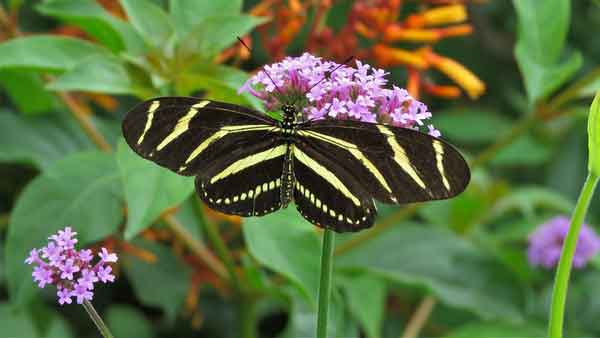
Landscaping and Design Ideas with Verbena
Verbena plants add vibrant color, texture, and charm to various garden designs. Here are some landscaping and design ideas to incorporate verbena into your outdoor space:
Cottage Gardens
Create a romantic, informal atmosphere by incorporating verbena into a cottage-style garden. Plant verbena alongside traditional cottage garden favorites like roses, lavender, and delphiniums. The soft, billowy appearance of verbena, combined with its colorful blooms, adds a sense of enchantment to this classic garden style.
Mixed Borders
Enhance your garden borders by adding verbena plants among other perennials, shrubs, and ornamental grasses. Verbena’s long-lasting blooms provide continuous color throughout the growing season, while its airy growth habit adds texture and contrast.
Container Gardens
Verbena plants make excellent additions to container gardens, either as a standalone centerpiece or combined with other flowering or foliage plants. Choose compact verbena varieties or trailing types, such as Verbena ‘Tapien’ or ‘Superbena’, to create a stunning display in pots, window boxes, or hanging baskets.
Rock Gardens
Incorporate drought-tolerant verbena species, like Verbena rigida or Verbena tenuisecta, into rock gardens or xeriscapes. These plants thrive in well-draining soils and add a pop of color to these low-maintenance landscapes.
Pollinator Gardens
Attract butterflies, bees, and hummingbirds to your garden by planting verbena. Its nectar-rich blooms provide an essential food source for these beneficial pollinators. Combine verbena with other pollinator-friendly plants, such as echinacea, salvia, and monarda, to create a vibrant, buzzing haven.
Vertical Gardens
Utilize verbena’s cascading growth habit to add visual interest to vertical gardens or green walls. Plant trailing verbena varieties in wall-mounted planters, hanging baskets, or vertical planter pockets to create a stunning, living tapestry of color.
Garden Pathways
Line your garden pathways or walkways with verbena plants to create a colorful, inviting passage. Plant taller verbena varieties, like Verbena bonariensis, along the back of the border, and use shorter or trailing types, such as Verbena ‘Homestead Purple’ or ‘Lanai’, as a low-growing edging.
By incorporating verbena into your landscape and garden design, you will create a captivating outdoor space full of color, texture, and visual appeal.
Frequently Asked Questions about Verbena
Q: How often should I water my verbena plants?
A: Water your verbena plants deeply and consistently, allowing the soil to dry out slightly between waterings. During their initial growth phase, they require more consistent watering. In periods of drought or extreme heat, you may need to water more frequently to prevent wilting.
Q: Do verbena plants need full sun?
A: Yes, verbena plants perform best in full sun exposure. They require at least six hours of direct sunlight daily to promote healthy growth and abundant flowering.
Q: How do I encourage more blooms on my verbena plants?
A: To encourage more blooms, regularly deadhead spent flowers and pinch back the growing tips of young plants. This promotes branching and a bushier growth habit, which results in more flowers. Additionally, applying a balanced fertilizer during the growing season can support blooming.
Q: Are verbena plants deer-resistant?
A: Verbena plants are generally considered deer-resistant. While deer may occasionally nibble on them, they are not a preferred food source. However, it is important to remember that deer-resistant plants are not deer-proof, and hungry deer may still browse on them in certain situations.
Q: Can verbena be grown indoors?
A: Verbena can be grown indoors in a bright, sunny location, such as a south-facing windowsill. However, they may not bloom as profusely indoors as they do outdoors due to limited light exposure. Be sure to provide adequate light, consistent watering, and proper air circulation for healthy indoor growth.
Q: How do I overwinter my verbena plants?
A: To overwinter verbena plants, apply a thick layer of organic mulch around the base after the first hard frost. For tender varieties or those in colder climates, provide additional protection using frost blankets, cloches, or cold frames. Container-grown verbena can be moved to a sheltered location or overwintered indoors.
Q: Are verbena plants toxic to pets?
A: Some species of verbena can be toxic to pets if ingested in large quantities. Symptoms may include vomiting, diarrhea, and abdominal pain. It is best to keep your pets away from verbena plants and consult your veterinarian if you suspect your pet has ingested any part of the plant.
Q: Can I grow verbena from seeds?
A: Yes, verbena can be grown from seeds. Start seeds indoors 8-10 weeks before your last frost date or sow them directly outdoors after the threat of frost has passed. Lightly press the seeds into the soil surface, as they require light to germinate. Maintain consistent moisture and a temperature of 70-75°F (21-24°C) until germination occurs, typically within 14-21 days.

